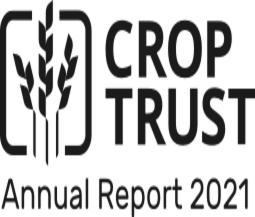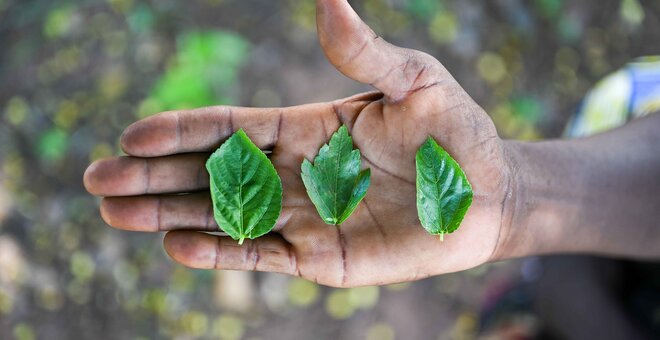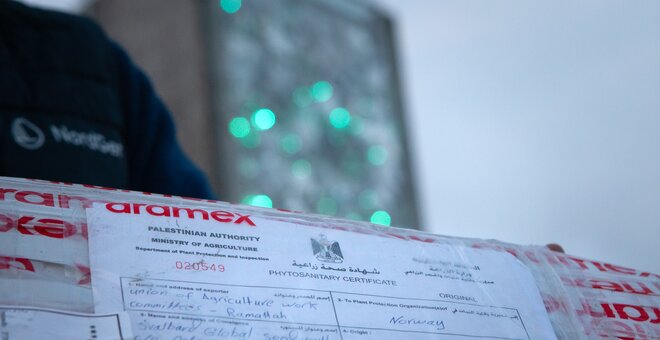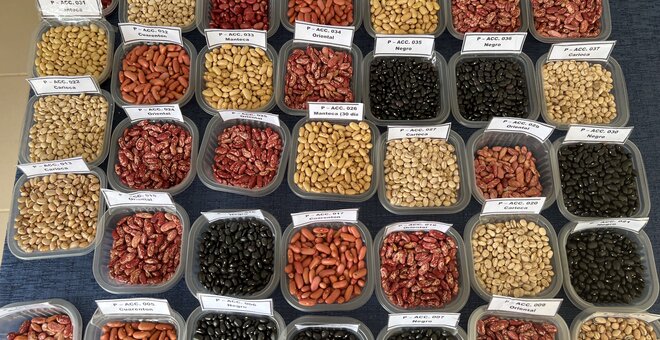The Svalbard Global Seed Vault
In 2022, no fewer than 30 genebanks from 28 countries deposited a total of nearly 85,000 seed samples in the Svalbard Global Seed Vault. This included four first-time depositors: the Directorate of Seed Testing and Certification, Iraq; the State Forest Service, Lithuania; the Spanish Plant Genetic Resources Centre, Spain; and the National Institute for Agricultural Research (INIA), Uruguay. A total of more than 90 applications for grants to support backing-up their collections in the Seed Vault were submitted by genebanks from all around the world. By year’s end, 18 of these had been approved, and more were being processed.
At a glance
The Svalbard Global Seed Vault is a long-term seed storage facility holding backups of the world’s collections of crop diversity. It is located deep inside a mountain on a remote island in the Svalbard archipelago near the North Pole, and is opened a few times a year for deposits.
The Seed Vault was established and is owned by Norway and operates as a partnership between the Norwegian Ministry of Agriculture and Food, the Nordic Genetic Resource Center (NordGen) and the Crop Trust.
The year in numbers
29
genebanks sent seeds to the Seed Vault
4
new genebanks added to the Seed Vault depositor family
84,984
samples were deposited
3
openings of the Seed Vault (February, June and October)
The Seed Vault in numbers
1,195,244
seed samples safeguarded
5,969
species represented
93
genebanks have deposited collections, from more than 60 countries
New ICARDA deposit brings holding almost back to 2015 level
In February 2022, the International Center for Agricultural Research in the Dry Areas (ICARDA) deposited more than 6,000 seed samples in the Svalbard Global Seed Vault. This deposit increased ICARDA’s holdings in the Seed Vault to almost 100,000 samples. That is close to what it was before the center withdrew seeds from the Seed Vault back in 2015, 2017 and 2019 to reestablish its genebank collection in Lebanon and Morocco following the civil war in Syria. ICARDA deposited an additional 3,446 seed samples in June.
The Svalbard family continues to grow
Four institutes backed up collections in 2022. In June, first-time deposits were received from the Spanish Plant Genetic Resources Center and the State Forest Service of Lithuania. In October, the Directorate of Seed Testing and Certification, Iraq, and the National Institute for Agricultural Research (INIA) of Uruguay followed with their own first-time deposits.
“We welcome these new members of our family and hope to see more seeds from them in the years to come,” said Sandra Borch, Norway’s minister of agriculture and food. “We look forward to seeing more nations entrusting their backup seeds to the Seed Vault.”
Something old, something new
The deposit in February included the seeds of crop species not previously represented in the Seed Vault. This included nearly 100 forage species from the Australian Pastures Genebank and 50 crop species from the Leibniz Institute of Plant Genetics and Crop Plant Research (IPK) in Germany. The IPK deposit also included samples of wheat collected in the Austrian Alpine region in the 1920s—one of the oldest collections at the genebank.
In June, the World Vegetable Center deposited seed samples from local varieties of rice bean, lablab and yard-long bean on behalf of two Indigenous communities.
Frequent flyer
In June 2022, the US-based non-governmental organization Seed Savers Exchange (SSE) deposited one box containing 99 seed samples. Although this was not a huge deposit, it continues SSE’s record as the only genebank in the world to have sent seeds to the Seed Vault every year since it opened in 2008—quite an achievement.
Related news and resources
Celebration Meets Urgency at Latest Seed Vault Opening in Svalbard
LONGYEARBYEN, NORWAY, 22 October 2025 – Twenty genebanks representing every continent bar Antarctica deposited more than 21,000 seed samples to the Svalbard Global Seed Vault this week. Among them were new contributors from the...
22 Oct 2025
Svalbard Global Seed Vault Deposit - October 2025
The Svalbard Global Seed Vault opens its doors to receive a shipment of the world's crop diversity for the third time this year.
Members of the media are welcome to attend. To register, please contact media@croptrust.org.
21 Oct 2025
21 Oct 2025
ABC News Australia: Interview with Dr. Stefan Schmitz
In an interview with ABC in Australia, Dr. Stefan Schmitz of the Crop Trust sat down with Kath Sullivan to discuss how the Crop Trust continues the vital work of safeguarding global crop diversity. Dr. Schmitz emphasized the...
13 Apr 2025
The New York Times: The World’s Doomsday Plant Vault Gets Thousands of New Seeds
The world’s seed savers are racing to safeguard the world’s crop diversity in “the world’s doomsday garden shed,” writes Amelia Nierenberg in her The New York Times report of the final 2024 depositor event at the Svalbard Global...
29 Oct 2024
Bloomberg: Arctic Vault Stashes More Seeds for Future Food
As reported by Bloomberg, 23 depositors from 21 countries sent boxes of seeds that contain over 30,000 seed samples for safekeeping at the Svalbard Global Seed Vault in Norway. This underlines the urgent need to preserve crop...
25 Oct 2024
His Majesty King Charles III Continues Patronage of Crop Trust
June 3, 2024 – Bonn, Germany – The Crop Trust is delighted that, following a review of the patronages of the late Queen and the former Prince of Wales, His Majesty King Charles III has decided to continue to be its Patron....
3 Jun 2024











